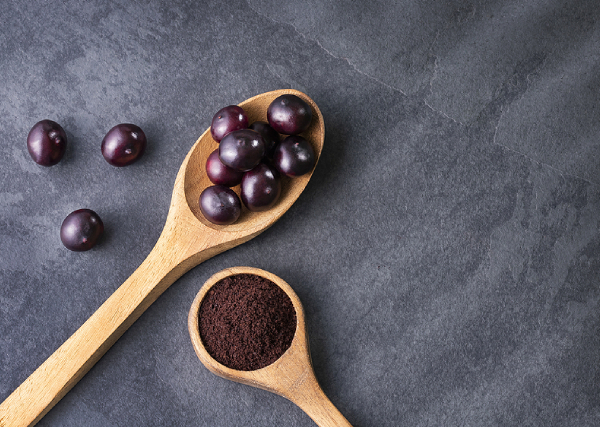Deep red, purple, and blue fruits offer a wide range of health benefits, and açaí berries are no exception.
In this article, we will be shining a spotlight on anthocyanins—the natural compound that gives these berries their colour—and delving into their many benefits.
What Are Anthocyanins?
Anthocyanins are water-soluble pigments that give fruits like blueberries and açaí berries their rich purple colour.
Anthocyanins are a type of flavonoid, which are part of a larger group of antioxidants named polyphenols, that helps plants reproduce while protecting them from environmental stressors like ultraviolet rays and drought. They are believed to treat conditions related to oxidative stress and inflammation, protecting the body from cognitive decline, cancer, diabetes, and heart disease.
Some other plants that contain anthocyanin include:
- Vegetables: Purple corn, red cabbage, and red radishes.
- Fruits: Blueberries, pomegranates, and cherries.
- Legumes and rice: Black soybeans, black beans, and black rice.
Several studies over the years have found that anthocyanins exhibit antioxidant, anti-carcinogenic, and anti-inflammatory activities. Moreover, they are believed to reinforce the immune system, reducing your susceptibility to health concerns.
Protect Against Free Radicals
All individuals are constantly exposed to free radicals. They occur as a by-product of metabolism and are created when the body is in contact with pollutants, ultraviolet rays, and harmful chemicals. Because these molecules are unstable, they may damage your cells and cause oxidative stress, leading to health ailments like heart disease and cancer.
As such, it is beneficial to consume antioxidants, which protect the body from free radicals. As anthocyanins have exceptional antioxidant properties, they can boost your health and well-being.
Anti-Inflammatory Effects
Inflammation is a natural response that helps your body heal. However, it poses a problem when it becomes chronic—chronic inflammation can lead to various health ailments such as type 2 diabetes and heart disease.
Studies have found that anthocyanin supplementation can help prevent or treat chronic inflammatory diseases (Karlsen et al., 2007). Therefore, they are capable of alleviating discomfort resulting from chronic inflammation.
Give the Brain a Boost
Contemporary studies have suggested that anthocyanins may boost brain health; this is likely because they protect the brain from oxidative stress and inflammation, which are associated with neurodegeneration (Li et al., 2021).
Reduce Blood Pressure
According to a review of 66 studies, blood pressure was lowered when anthocyanin-rich berries were consumed. As such, anthocyanins can help lower blood pressure, thus reducing the risk of cardiovascular problems (Vendrame & Klimis-Zacas, 2019).
May Slow Cancer Growth
Anthocyanins have been found to inhibit malignant cell growth and stimulate apoptosis (Wang & Stoner, 2008). Additionally, studies show that anthocyanins can interact with cancer cells and may be a potential therapeutic agent for colorectal cancer prevention (Medic et al., 2019; Shi et al., 2021).
Hence, the anthocyanins in açaí could delay cancer growth.
Protect Against Diabetes
Anthocyanins can lower blood sugar levels by boosting insulin resistance and reducing the digestion of sugars in the small intestine. Hence, anthocyanin-rich foods were associated with lower insulin and inflammation levels (Jennings et al., 2014).
Conclusion
Açaí berries are packed with anthocyanins, which have numerous health benefits. Hence, regularly consuming anthocyanin-rich food, like açaí bowls and smoothies, can improve your physical health and well-being while enjoying a delicious snack.
Are you interested in buying açaí pulp puree, açaí sorbet ready to serve, açaí popsicles, and açaí wholesale in Singapore? Please contact Selva Earth for more information.
References
Jennings, A., Welch, A. A., Spector, T., Macgregor, A., & Cassidy, A. (2014). Intakes of Anthocyanins and Flavones Are Associated with Biomarkers of Insulin Resistance and Inflammation in Women. Nutrition, 144(2), 202-208. https://doi.org/10.3945/jn.113.184358
Karlsen, A. S., Retterstol, L., Laake, P., Ingvild, P., Siv, K., Leiv, S., & Rune, B. (2007). Anthocyanins inhibit nuclear factor-kappaB activation in monocytes and reduce plasma concentrations of pro-inflammatory mediators in healthy adults. Journal of Nutrition, 137(8), 1951-1954. https://doi.org/10.1093/jn/137.8.1951
Li, P., Feng, D., Yang, D., Li, X., Sun, J., Wang, G., Tian, L., Jiang, X., & Bai, W. (2021). Protective effects of anthocyanins on neurodegenerative diseases. Trends in Food Science & Technology, 117, 205-217. https://doi.org/10.1016/j.tifs.2021.05.005
Medic, N., Tramer, F., & Passamonti, S. (2019). Anthocyanins in Colorectal Cancer Prevention. A Systematic Review of the Literature in Search of Molecular Oncotargets. Front Pharmacol, 10. https://doi.org/10.3389/fphar.2019.00675
Shi, N., Chen, X., & Chen, T. (2021). Anthocyanins in Colorectal Cancer Prevention Review. Antioxidants, 10(10), 1600. https://doi.org/10.3390/antiox10101600
Vendrame, S., & Klimis-Zacas, D. (2019). Potential Factors Influencing the Effects of Anthocyanins on Blood Pressure Regulation in Humans: A Review. Nutrients, 11(6), 1431. https://doi.org/10.3390/nu11061431
Wang, L., & Stoner, G. D. (2008). Anthocyanins and their role in cancer prevention. Cancer Letters, 269(2), 281-290. https://doi.org/10.1016/j.canlet.2008.05.020
